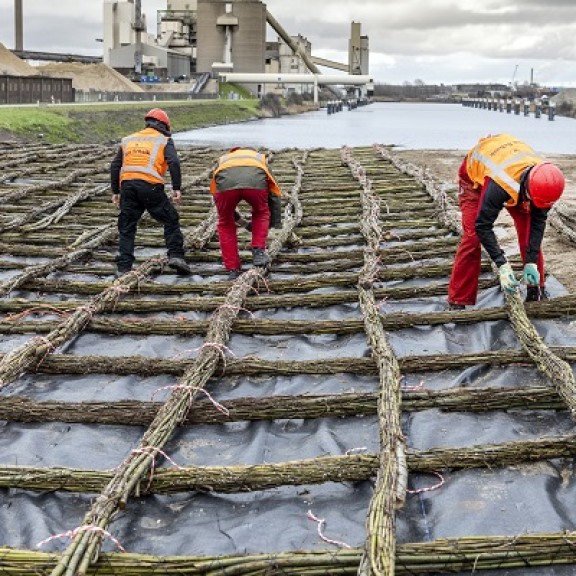
Three questions to Bart and Henk about the bottom protection system for Zeesluis IJmuiden
A larger lock means bigger ships and more salt water. The locking process creates large volumes of fresh or salt water flowing into or out of the lock and water turbulence may scour out holes near the inner and outer lock heads, undermining them.
Special bottom protection layers are therefore applied at the inner and outer lock heads. Bart Broekman and Henk Vink of Combinatie BaggerIJ are in charge of the preparation and the application of the bottom protection layers. In this article they will answer three questions about bottom protection.
Why should the bottom near the lock heads be protected?
The locking process creates large volumes of fresh or salt water flowing into or out of the lock which may scour out holes near the inner and outer lock heads, undermining them. In order to reduce this effect, the bottom at the entrances of the lock near the inner lock head (canal side) and the outer lock head (seaward side) will receive extra protection layers. Also the area next to the outer approach wall up to the guard wall will receive a special protection layer. Without bottom protection layers along the lock walls, the scouring action of turbulent water could cause unwanted sand transport along these walls. This could have consequences for shipping traffic, as sand transport could cause changes in water depth in or near the lock. By applying bottom protection layers, we prevent this from happening. Extra attention must be paid to the connection of the protection layers to the lock walls.”
What does a bottom protection layer consist of?
“Our bottom protection method consists of applying two layers of material. The first layer of the bottom protection system is made of bundles of willow connected to a filter cloth. The bundles are tied together crosswise by hand in sections measuring 1 metre by 1 metre. The willow branches give strength to the filter cloth during the transport and the underwater installation and provide a solid first bottom protection layer. The filter cloth also ensures that no sand gets through the bottom protection layers. Due to the light weight of the willow bundles, the filter cloth can easily be lowered and positioned underwater next to the walls and lock heads. This first layer is also called the fascine mattress. The second layer of bottom protection is put on top of the filter cloth and the willow bundles. This second layer consists of rip-rap, loose stone used as ballast.“
How is bottom protection applied?
“In many places, the riprap layer is encased in concrete to ensure that it will not be swept away by water flows due to currents or ships’ propeller movements (wash). Each individual compartment of the fascine mattress on the bottom is covered by concrete by means of a grab which releases the concrete just above the bottom. We have tested this technique with divers and they have told us that it worked OK. After completion, the divers will carry out random checks to see whether every segment has been covered with enough concrete. To ensure that the sandy soil next to the lock walls will remain in place, the riprap along all the walls will be covered by a so-called colloidal concrete mix. This is a special type of concrete that does not dissolve during the pouring process and is not washed away by water currents. The gravel in this concrete comes from K3Deme, a company based in the port of Amsterdam.'
The bottom protection layers ultimately ensure that the bottom of the lock will continue to remain at the required depth and that the sand will not be swept away by water turbulence in the lock. This type of soil protection is expected to protect the bottom of the lock for more than 100 years.